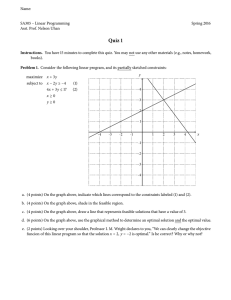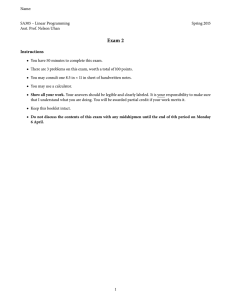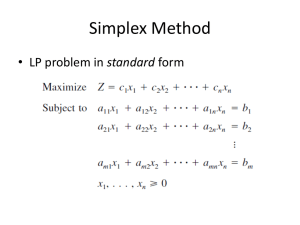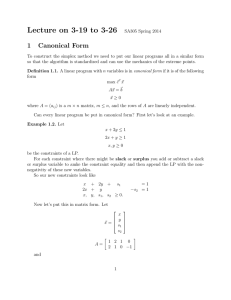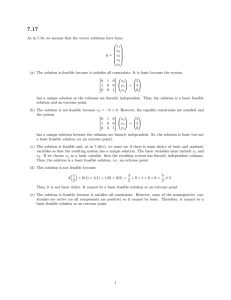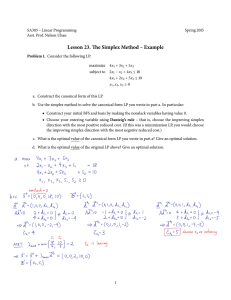Glossary of terms
advertisement
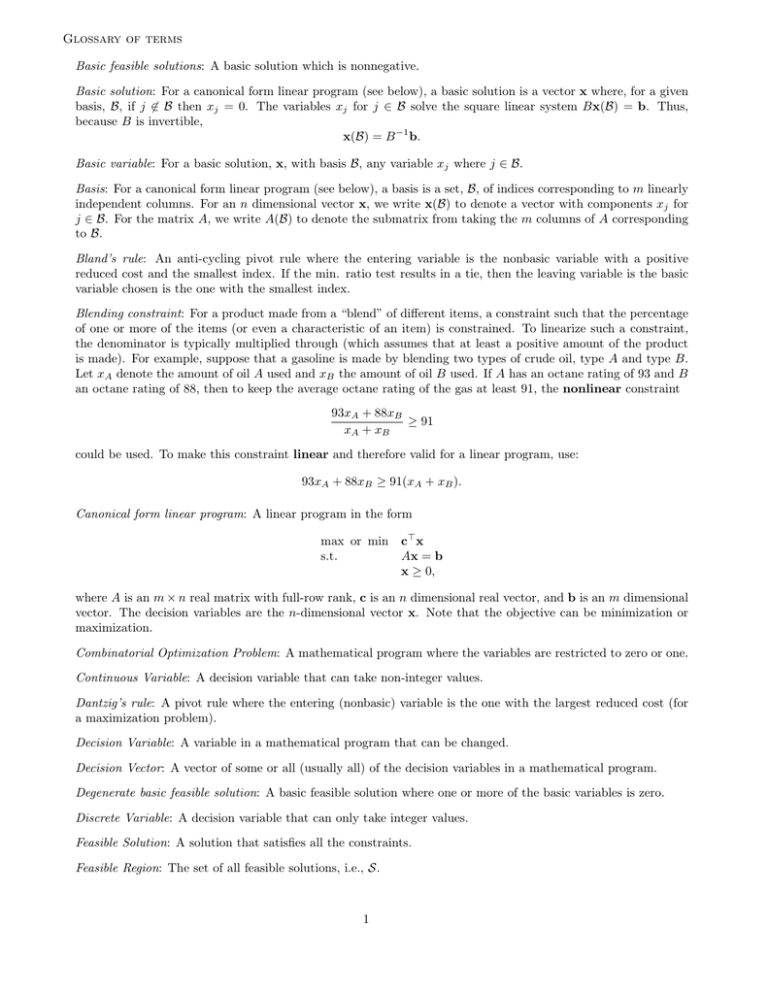
Glossary of terms
Basic feasible solutions: A basic solution which is nonnegative.
Basic solution: For a canonical form linear program (see below), a basic solution is a vector x where, for a given
basis, B, if j 6∈ B then xj = 0. The variables xj for j ∈ B solve the square linear system Bx(B) = b. Thus,
because B is invertible,
x(B) = B −1 b.
Basic variable: For a basic solution, x, with basis B, any variable xj where j ∈ B.
Basis: For a canonical form linear program (see below), a basis is a set, B, of indices corresponding to m linearly
independent columns. For an n dimensional vector x, we write x(B) to denote a vector with components xj for
j ∈ B. For the matrix A, we write A(B) to denote the submatrix from taking the m columns of A corresponding
to B.
Bland’s rule: An anti-cycling pivot rule where the entering variable is the nonbasic variable with a positive
reduced cost and the smallest index. If the min. ratio test results in a tie, then the leaving variable is the basic
variable chosen is the one with the smallest index.
Blending constraint: For a product made from a “blend” of different items, a constraint such that the percentage
of one or more of the items (or even a characteristic of an item) is constrained. To linearize such a constraint,
the denominator is typically multiplied through (which assumes that at least a positive amount of the product
is made). For example, suppose that a gasoline is made by blending two types of crude oil, type A and type B.
Let xA denote the amount of oil A used and xB the amount of oil B used. If A has an octane rating of 93 and B
an octane rating of 88, then to keep the average octane rating of the gas at least 91, the nonlinear constraint
93xA + 88xB
≥ 91
xA + xB
could be used. To make this constraint linear and therefore valid for a linear program, use:
93xA + 88xB ≥ 91(xA + xB ).
Canonical form linear program: A linear program in the form
max or min
s.t.
c> x
Ax = b
x ≥ 0,
where A is an m × n real matrix with full-row rank, c is an n dimensional real vector, and b is an m dimensional
vector. The decision variables are the n-dimensional vector x. Note that the objective can be minimization or
maximization.
Combinatorial Optimization Problem: A mathematical program where the variables are restricted to zero or one.
Continuous Variable: A decision variable that can take non-integer values.
Dantzig’s rule: A pivot rule where the entering (nonbasic) variable is the one with the largest reduced cost (for
a maximization problem).
Decision Variable: A variable in a mathematical program that can be changed.
Decision Vector: A vector of some or all (usually all) of the decision variables in a mathematical program.
Degenerate basic feasible solution: A basic feasible solution where one or more of the basic variables is zero.
Discrete Variable: A decision variable that can only take integer values.
Feasible Solution: A solution that satisfies all the constraints.
Feasible Region: The set of all feasible solutions, i.e., S.
1
Graph: A set, V, of nodes (or vertices) and a set of pairs of nodes, called edges (or arcs), E, typically written
G = (V, E) and can be drawn as (arbitrarily placed) small circles in space for each i ∈ V with a line between
nodes i and j if (i, j) ∈ E. We typically use directed graphs, which means the order of the edge matters, i.e.,
(i, j) 6= (j, i) for i 6= j. Note that we also assume that graphs do not have loops, i.e., edges from a node to itself,
or multiedges, multiple copies of an edge.
Infeasible Problem: A mathematical program where S = ∅, i.e., where no feasible solution exists.
Infeasible Solution: A solution, x, that does not satisfy the constraints, i.e., x 6∈ S.
Linear Program (LP): A mathematical program where f is linear and S is determined by linear inequalities and
equalities. This can be written as
max
s.t.
c1 x 1 + . . . + cn x n
ai1 x1 + . . . + ain xn
≤ bi , i = 1, . . . , m.
We can show that every LP can be written in this form. Linear programs assume additivity, certainty, divisbility,
and proportionality.
Mathematical Program: Also called an optimization problem, a mathematical program consists of a given set
S ⊂ Rn and function f : S → R. Then, the mathematical program is
max{f (x) : x ∈ S} or min{f (x) : x ∈ S}.
Minimum ratio test: For a canonical form linear program, basic solution, x, with basis, B, and simplex direction
d(j) , the minimum ratio test is the calculation used to determine the maximum step size, λ, that can be used
before x+λd(j) is not feasible. Because x+λd(j) satisfies equality constraints for any λ, the step size is determined
in order to satisfy the nonnegativity constraints, i.e., λ is the maximum value such that, for all i,
(j)
xi + λdi
(j)
For nonbasic indices i, xj + λdi
≥ 0.
≥ 0 so the minimum ratio test is calculated via
λ = min{
xi
(j)
−di
|i ∈ B, di < 0}.
Nonbasic variable: For a basic solution, x, with basis B, any variable xj where j 6∈ B. All nonbasic variables are
zero, i.e., xj = 0 for j 6∈ B.
Pivot rule: How an entering is picked in Simplex. Pivot rules are only used if there is an improving direction (i.e.,
at least one positive reduced cost for a max problem or at least one negative reduced cost for a min problem).
Some pivot rules also specify how leaving variables are chosen in the event of a tie in the minimum ratio test.
Optimal Solution: A feasible solution, x∗ , that has, for all x ∈ S:
f (x∗ ) ≥ f (x) for a maximization problem, or;
f (x∗ ) ≤ f (x) for a minimization problem.
Reduced cost: For a canonical form linear program and a basic feasible solution with basis, B, and basis matrix
B = A(B), the reduced cost of the nonbasic variable with index j 6∈ B is the directional derivative of the objective
function, c> x in the simplex direction d(j) , i.e.,
cj = Dd(j) (c> x) = ∇(c> x) · d(j) = c · d(j) = cj − c(B)> B −1 Aj .
Reduced cost optimality conditions: For a canonical form linear program, a basic feasible solution with basis, B,
is optimal for a maximization problem if, for all j 6∈ B,
cj ≤ 0.
For a minimization problem, the condition is that for all j 6∈ B,
cj ≥ 0.
2
Simplex direction: For a canonical form linear program and a basic feasible solution, x, with basis, B, and basis
matrix B = A(B), the simplex direction of the nonbasic variable with index j 6∈ B is an n-dimensional vector d(j)
(j)
(j)
where dj = 1, for i 6∈ B, i 6= j, di = 0 and
d(j) (B) = −B −1 Aj .
Note that Aj is the jth column of A. Also recall that the derivation of d(j) was based on (1) changing only one
non-basic variables, and (2) satisfying all the equality constraints for any change from the basic feasible solution,
x, i.e., for any λ and j 6∈ B.
A(x + λd(j) ) = b.
Solution: A particular setting of the decision vector. Note that the solution may not satisfy all the constraints.
Unbounded Mathematical Program: A mathematical program where for any K > 0, for a maximization, there
exists a feasible solution x with f (x) > K. For a minimization problem, for any K < 0 there is a feasible solution
x with f (x) < K.
3

